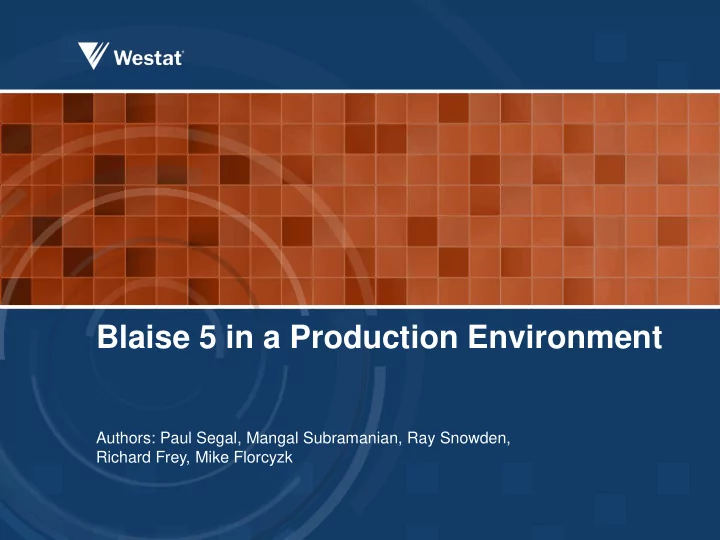

Blaise 5 in a Production Environment Authors: Paul Segal, Mangal Subramanian, Ray Snowden, Richard Frey, Mike Florcyzk
Presentation Overview Blaise 5 Server and Client Options. Blaise 5 API Use Case. Stress Testing Blaise 5 Application
Blaise 5 Server Roles Web server – processes requests and send responses to end users Resource Server – applies layout and formats Blaise 5 for different devices types Data Entry Server – interprets/applies Blaise rules Data Server – reads and writes to the Blaise data source Survey Manager supports Server Role administration
Blaise 5 Server Park A Server Park is the collection of physical servers on which the Blaise server roles are installed Considerations for Server Park design Scalability – scale out or scale up Continuity – eliminate single points of failure Security – isolate servers from end-user access and practice secure server configuration and management practices Blaise 5 production configuration also requires a database server running a supported DBMS – SQL Server, MySQL, Oracle
Blaise 5 Client Options Connected options – supported in first release Web browsers – various standard browsers and mobile browsers Blaise 5 mobile app for iOS – thin client Disconnected options Blaise 5 under Windows for CAPI ( Linux? ) Blaise 5 mobile app for disconnected operations – thick client
Blaise 5 API: Overview Until Manipula becomes available in Blaise 5, the API becomes the mechanism for data manipulation. Blaise 5 has four API’s organized functionally. o MetaAPI o DataRecord o DataLink o SessionData Blaise 5 API is built entirely with .NET Framework (.NET 4.0).
Blaise 5 API: Use Cases Typical use of Blaise API in a production environment may include the following use cases; Preloading data into the instrument for a case. Returning case-level status information. Extracting case results. Blaise Agent; .NET Wrapper that provided a generic implementation of the above three Blaise API functions. Re-usable across projects.
Blaise 5 API: Observations The API has been re-organized compared to Blaise 4. The organizational by functions seems more logical and natural. Use of the new Blaise API for new and old users involves a bit of a learning curve. On the other hand there is the advantage of someone without have knowledge of Manipula being able to work with Blaise data using the .NET API.
Blaise 5 API: References by Function Initialization o MetaAPI to access DataModel object o DataLinkAPI to access DataLink object Preloading data for a case o DataRecordAPI to create DataRecords and set values from source o MetaAPI to access non-response values (SpecialAnswerNames) o DataLinkAPI to write DataRecords to DataSet Returning case-level status information o DataRecordAPI to retrieve DataRecord and read values o MetaAPI to access key fields Extracting case results (all records) o DataLinkAPI to access Blaise 5 DataSet o DataRecordAPI to process DataRecords in DataSet o MetaAPI to access key fields
Blaise 5 API Tips: Preloading data for a case To set the value for a Blaise 5 field (fld): – for an enumerated field, use the integer value fld.DataValue.EnumerationValue = int.Parse(fieldValue) – for a date field, use a DataRecordAPI DataValue (dv) and its DateValue dv.DateValue = DateTime.Parse(fieldValue) fld.DataValue.Assign(dv) – for a non-response value use SpecialAnswers fld.DataValue.SpecialAnswer = MetaAPI.Constants.SpecialAnswerNames.DontKnow
Blaise 5 Stress Testing: Overview Factors affecting capacity and performance of the Blaise application are; Number of users and expected distribution of users over time. Size of the data model. Size and configuration of the server hardware. Stress Testing Goals; Define a consistent and reliable stress testing approach. Determine key stress testing parameters.
Blaise 5 Stress Testing: Test Design Factors Test Server Configuration; – One Virtual Blaise 5 server running Windows 2008 server. – SQL server 2008 running on a separate database server. Record a test script with parameters and attributes that best replicates a real life user interaction scenario. Determine simultaneous users threshold. Record and monitor response times.
Blaise 5 Stress Testing: Tool and Scripts The tool used for stress testing was the Microsoft Visual Studio Test Manager. Provides ability to record a Web Test script by recording a user session against a Blaise 5 web survey. The Web Test can be associated with a Load Test. Load Test allows one to specify various test parameters like - No. Of users, Test run time, Think time. The test tool allows to record all key strokes that a user inputs during a survey session including time taken between questions.
Blaise 5 Stress Testing: Factors Number of processors and amount of memory on the server has effect on performance (easier to make since they were in a Virtual environment). Configuration of client machines an important factor. Mixture of short and long running tests.
Blaise 5 Stress Testing: Metrics A key metric in web applications is the response time. Requests Queued – The more requests queued indicates server bog down, until you get a service unavailable error. Worker Process re-starts – Important monitor, each worker process has a set memory allocated, so if there are memory leaks it would re-start.
Blaise 5 Stress Testing: Tool Metrics In addition to these performance counters, following key metrics captured by the test tool were used to determine the health of the application under various loads. Tests/Sec Tests Failed Avg. Test Time (sec) Pages/Sec Avg. Page Time (sec) Requests/Sec Requests Failed Avg. Response Time (sec)
Recommend
More recommend